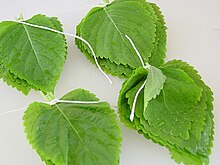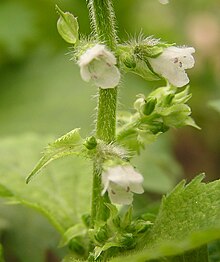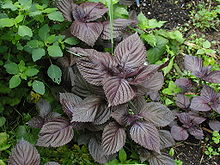Perilla
| Perilla | ||||||||||||
|---|---|---|---|---|---|---|---|---|---|---|---|---|

Perilla ( Perilla frutescens ) |
||||||||||||
| Systematics | ||||||||||||
|
||||||||||||
| Scientific name of the genus | ||||||||||||
| Perilla | ||||||||||||
| L. | ||||||||||||
| Scientific name of the species | ||||||||||||
| Perilla frutescens | ||||||||||||
| ( L. ) Britton |
The perilla ( Perilla frutescens ), also Shiso , Egoma ( Japanese シ ソ , 紫蘇 ), Kkaennip ( Kor. 깻잎 , [k͈ɛɲɲip] ), sesame leaf or inaccurately black nettle (not to be confused with the ballota nigra , which is more often called black nettle ), also misleading wild sesame called, is a plant from the mostly as monotypic prestigious genus Perilla in the family of the mint (Lamiaceae). Its leaves and seeds are used for seasoning and medicinal purposes. This type of plant thrives especially in sunny or partially shaded locations, can be cultivated in the garden without any problems and has a high ornamental value.
Occurrence
The original range of this plant species is not known. Mountain ranges in India and China are discussed as regions of origin . Nowadays it is found in East, Southeast and South Asia. It is widely cultivated in gardens and grows wild on wasteland . In North America it is a neophyte.
description
The annual herbaceous plants usually reach heights of growth between 30 cm and 60 cm in temperate climates, but can also become significantly larger. The plants are green to dark purple and hairy short and rough to shaggy. The cross-opposite, simple, egg-shaped to rounded or elliptical and stalked leaves are more coarsely serrated, notched or toothed and drawn out into a short to long point. The leaves are slightly hairy on the underside, on the veins . The veins are pinnate and embossed in relief on the top and raised on the underside.
The long, short-stalked, terminal and lateral inflorescences are characteristic . Their pseudo whorls are two-flowered, but side branches with further, often crowded flower whorls are on one side in the nodes. The entire inflorescence is hairy shaggy. The bracts are about 4 mm long and wide.
The hermaphrodite, zygomorphic , short-stalked flower is five-fold with a double flower envelope. The five, more or less hairy sepals are fused bell-shaped. The upper lip of the calyx is three-lobed, with the middle lobe being smaller. The lower lip is bilobed. The lobes are lanceolate. As the fruit ripens, the calyx enlarges and swells on one side. The 3 to 4 mm long, partly hairy crown is white to purple-red. Your upper lip is blunt to shallow at the front. The lower lip is three-lobed, with the two side lobes slightly smaller and standing to the side. The four, slightly protruding stamens are about the same length. The stylus does not protrude beyond the corolla tube.
Small, grayish to brown, reticulate veined and about 1.5–3 millimeters large, rounded Klausen fruits are formed.
The number of chromosomes is 2n = 40.
ingredients
Perilla oil is obtained from the seeds of the plant . The main component of perilla oil is perillaaldehyde. The synthetically produced oxime of perilla aldehyde is used as the sweetener perillartin . The seed is high in linolenic and linoleic acid .
Other ingredients of Perilla are tannins (including rosmarinic acid and caffeic acid ) and various flavones (including luteolin ). The variety Purpurascens is also rich in anthocyanins .
Use and effect
The aroma of Perilla or shiso as in Japan is called, is slightly minty . Fresh and pickled leaves and seeds flavor Japanese dishes such as sushi and tempura . For Umeboshi , they are indispensable.
In Korea , the leaves ( kkaennip 깻잎 [k͈ɛɲɲip] ) are eaten fresh as a salad, or they are placed in salty, hot spices and used as a side dish. The oil pressed from the seeds is used in East Asia as an edible oil or spice. The roasted seeds, which have a nutty aroma, are also used in Chinese cuisine to fill flat cakes and mantou .
The red (variety Purpurascens) and green Shiso (variety Crispa) sometimes have significant differences in taste. The red shiso has a clear anise and mint note, whereas the green shiso tastes more like lemon. Green Shiso develops a cinnamon-like aroma when it wilts and marinates for a long time.
The decoction of the herb has an antispasmodic, laxative and expectorant effect, as well as against nausea and colds. The oil is valued primarily as a medicine. Since it is one of the drying oils , it is also used in technology similar to linseed oil .
Systematics


Perilla frutescens was first described by Linné as Ocimum frutescens . Over time, other synonyms came up: Dentidia nankinensis Lour. , Perilla arguta Benth. , Perilla nankinensis (Lour.) Decne. , Perilla ocymoides L.
It is unclear whether the genus consists only of the species Perilla frutescens and its varieties or whether these are to be assessed as separate species. The main distinguishing features are the perforation, shape and surface of the leaves and the shape and hairiness of the bracts and the calyx. There are also diploid and tetraploid groups of plants. A clarification of the system is made difficult by the many cultivars.
There are the following varieties:
- Perilla frutescens var. Crispa (Bentham) Deane ex Bailey : The number of chromosomes is 2n = 40. It occurs in Japan.
- Perilla frutescens ( L. ) Britton var. Frutescens : The number of chromosomes is 2n = 40. It occurs from Pakistan to Far Eastern Asian Russia.
- Perilla frutescens var. Hirtella (Nakai) Makino (Syn .: Perilla hirtella Nakai ): It occurs in Japan and Korea.
- Perilla frutescens var. Purpurascens (Hayata) HWLi . According to R. Govaerts, it is to be assigned to Perilla frutescens var. Frutescens .
See also
literature
- Flora of China - Perilla .
- Miyuki Nitta et al .: The Distribution of Perilla Species. In: Genetic Resources and Crop Evolution. Volume 52, No. 7, Nov. 2005, pp. 797-804, doi : 10.1007 / s10722-003-6017-5 .
- Perilla , species list in Germplasm Resources Information Network (GRIN), USDA , ARS , National Genetic Resources Program. National Germplasm Resources Laboratory, Beltsville, Maryland.
- JC Roecklein, PS Leung: A Profile of Economic Plants. Transaction Books, 1987, ISBN 0-88738-167-7 , p. 349, limited preview in Google book search.
Web links
- Perilla frutescens at Useful Tropical Plants.
- Perilla frutescens at PROTA.
Individual evidence
- ↑ Perilla (Perilla frutescens (L.) Britton) Gernot Katzers Gewürzseiten, formerly at the University of Graz.
- ↑ a b c d e Rafaël Govaerts (Ed.): Perilla frutescens. In: World Checklist of Selected Plant Families (WCSP) - The Board of Trustees of the Royal Botanic Gardens, Kew . Retrieved September 14, 2019.
- ↑ J. Schormüller : Handbuch der Lebensmittelchemie. 4th volume: Fette und Lipoide (Lipids) , Springer, 1969, ISBN 978-3-662-23548-5 (Reprint), p. 373 f.
- ↑ a b c Perilla frutescens at Tropicos.org. In: IPCN Chromosome Reports . Missouri Botanical Garden, St. Louis
- ↑ Entry on perilla oil. In: Römpp Online . Georg Thieme Verlag, accessed on January 3, 2012.
- ↑ 苏 子 饼 的 做法, 苏 子 饼 怎么 做好 吃, 苏 子 饼 的 家常 做法 _ 半 老 女人 _ 好 豆 网. In: www.haodou.com. Retrieved August 29, 2016 .

